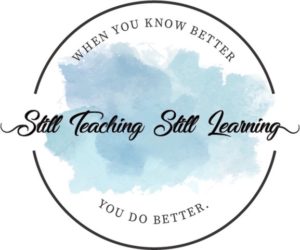
Have you ever heard of dialogue journals? When I think about routines that work well in upper elementary grades, dialogue journals are one of my top suggestions. I’ll explain how I use them in my classroom and I hope that it will become a helpful and meaningful routine for you as well.
Quick note — this routine is not just for upper elementary classrooms! I happen to teach fifth grade, but dialogue journals work for any grade.



I started using these journals about 20 years ago and found them to be incredibly informative for me and empowering for my students’ voices. Then I read the book I Wish My Teacher Knew: How One Question Can Change Everything for Our Kids by Kyle Schwartz and it further reinforced the importance of these journals.
HERE’S HOW I DO IT:
First, I get inexpensive notebooks for my kids like these marble cover ones or spiral notebooks. I watch for the summer sales at Staples or Target, or I buy them during Amazon Prime days.
When I get my class list, I put every child’s name on the cover. Some teachers like to give kids an opportunity to decorate their covers. Up to you!
Some teachers have asked me if you could do these journals via Edublog or some other tech tool. Yes, you could! I like the handwritten aspect of the journals and it makes it easy to send them home with students at the end of the year. But you should decide what works better for you.



I introduce the journals during the first week of school. I explain them in this way:
“Our school days go by quickly. During the day, I wish I had the time to sit down with every one of you and just have a private talk about whatever you want to talk about. Some days I might have more time for that than others, but I don’t like feeling like I am missing anyone. So this journal is one way that we can ‘talk’ privately.”
GETTING STARTED
Here are the guidelines I give to my students:
*You may write in your journal any time you want.
*I will give you one time a week that is specifically for writing in your journal. (I usually do this on Friday morning for about 10-15 minutes. Just try to find a small block of time that works for you.)
*Date every entry in your journal. That is to help me see when something happened or when something was written.
*Write your journal entry in letter form: start it with “Dear Mrs. Smith,” and end it by signing your name.
*Put your journal back in this crate so I can find it easily when I write back to you.
*Quick warning: journals are private. Your journal is for you and for me to see, no one else. Do not look at anyone else’s journal. That is a serious violation of privacy and there will be severe consequences for doing that. I know you wouldn’t even think of doing that (always assume positive intent on the part of your students!), but I’m reminding you just in case. 🙂
(Just for the record — I have never had students violate privacy. If that becomes an issue, I would suggest keeping the journal crate near your small group instruction table or where it can be more closely monitored.)



WHAT I DO WITH THE JOURNALS:
*I generally read and respond to about five journals per day. That is my goal, although some weeks that just does not happen. I assure my students that I will catch up and they should just keep writing to me. Sometimes I respond to three or four of their journal entries with just one of my own! That’s okay. As long as their concerns or questions are getting a response, it doesn’t matter.
*When I respond, I also write in letter form. If they are not writing in letter form, it models the correct form for them.
*I always sign my letters with “Love, Mrs. Smith.” If you are not comfortable with “love”, use some other word, but I try to use this opportunity to communicate my love and caring for the student.
*If a student has not written in their journal for a week or so, I remind them in my letter that I want to hear from them. I might even ask a couple of specific questions.
*Sometimes the things that students share are more personal or need more of a conversation with me. When that happens, I make a note of it on my to-do list first. Then I respond by letter that we need to have a conversation about it. Depending on what the issue is, I find time as quickly as possible to have that conversation. Sometimes it’s a quick chat. Other times, I need to get other resource help involved (school guidance counselor, etc.).
*I do keep track of student journal writing, but not for a grade. I keep a simple checklist and just put a check mark by their name when the student has written to me and I have responded. That way, I can see if it has been over a week or two and I have not heard from the student in their journal. Make this as easy as possible for yourself!



POSSIBLE JOURNAL PROMPTS TO USE:
*Tell me about this week! What was good? What was not so good?
*What is going well for you at school right now?
*What is not going well for you at school right now?
*What is going well for you outside of school right now?
*What is not going well for you outside of school right now?
*Who are your friends?
*Is there anyone you have trouble getting along with? Why?
*How is reading going for you right now?
*How is writing going for you right now?
*How is math going for you right now?
*How is social studies going for you right now?
*How is science going for you right now?
*What is your favorite special and why?
*What is your least favorite special and why?
*What did you think of . . . (the assembly, the field trip, etc.)
*What are you worried about right now?
*What do you love doing? Why?
*What makes you feel “smart”?
*What do you need from me right now?
*Do you have any suggestions for me?
*What do you want me to know?
These are just examples. I would love to hear any suggestions you have that work for you and your kids!



HOW DIALOGUE JOURNALS BENEFIT MY STUDENTS AND ME:
At the end of the year, my students always report that our dialogue journals are one of their favorite things about our class. They help build relationships between me and my students. They communicate that I really do care what is going on in their lives and that I really do care about what they think and what they have to say.
I learn so much about my students that I might never know otherwise. Some of the information I learn totally changes my perception of the child in a positive way. Some of the information explains some behaviors that I see and helps give me insight into how I can help support the student.
The journals help my students feel safe, that they are seen and known by me.
Give them a try this year! I would love to hear how they work for you.
